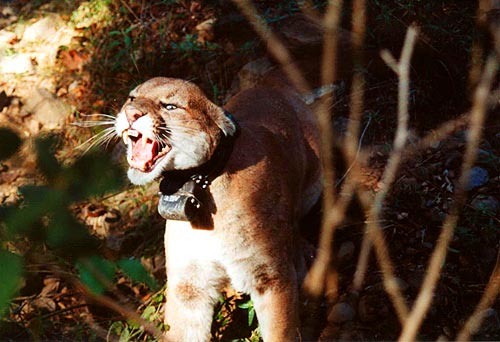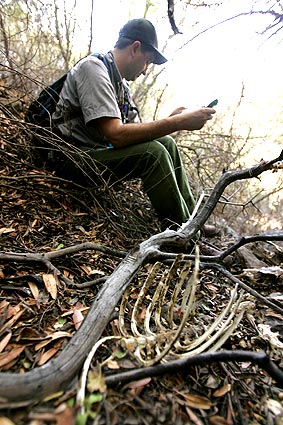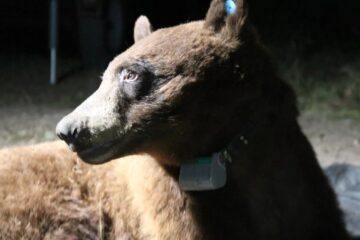Look who’s stalking: a new cougar killer
Another cub is killed. Was it the usual suspect or a newcomer?
Source of this article – Los Angeles Times, November 25, 2006.
Amanda Covarrubias
On Sept. 25, when the radio tracking collar of a young male mountain lion in the Santa Monica Mountains emitted a “mortality signal,” indicating it had not moved for at least eight hours, biologists feared the worst.
The 2-year-old puma, one of only three known mountain lions left in the coastal range, was either seriously wounded or dead.
Wildlife ecologist Seth Riley went to investigate, pinpointing the puma’s location from its collar and then heading out to the scrubby hills west of Topanga Canyon. There, he found the lifeless cat, its forelegs chewed and its head bearing several puncture wounds.
 It appeared that P1 had struck again.
It appeared that P1 had struck again.
P1, short for Puma 1, is the dominant male mountain lion in the Santa Monica Mountains and the father of the dead cougar.
Riley and the other National Park Service scientists who track the region’s mountain lions (also known as cougars or pumas) had been joyous in 2004 when P1 mated with the only other big cat researchers knew to live in the Santa Monicas. Later that year, she bore four kittens.
But since then, for reasons that remain unclear, P1 has gone on the attack, killing his mate and one of their offspring in 2005 and another cub in June. Now a third cub was dead, and P1 was the logical suspect.
When Riley returned to the ranger station to review the global positioning system data from P1’s collar, he was surprised at what he found.
GPS data showed that at the time the latest cub was killed, P1 was at least 35 miles from Topanga Canyon, roaming an area far to the west near Point Mugu. And that opened the door to an interesting possibility: Perhaps there was another cougar in the range.
Genetic tests of swabs taken from the dead lion’s claws confirmed that he had fought an adult mountain lion other than P1.
For Riley and his colleagues at the Santa Monica Mountains National Recreation Area, it was the latest twist in what has been an emotional saga.
For five years, they had tracked the mountain lions’ movements, hoping their research would help them and the public better understand how this resilient species adapts and survives in urban parkland.
Now, the idea of another adult male, one that had never been tagged by scientists and whose whereabouts were unknown, had added another layer of mystery to the tale.
“We have always said, just because these are the lions we know about these aren’t necessarily the only lions,” Riley said. “Another lion could move in, or there’s lions out there we just don’t know about.”
A solitary species
Riley and his colleagues at the largest urban national park in the U.S. began monitoring cougars in 2002, when they received state funding to launch the Mountain Lion Project. The scientific study was designed to allow researchers to learn more about the habits of cougars in the 154,000-acre park.
When they started the project, scientists had only a rough idea of how many pumas lived in the mountain range. Solitary by nature, the buff-colored cats generally avoid people. Bobcats, which look similar but are smaller, with tufts of hair sprouting from their ears, are much more prevalent.
To find the mountain lions at the beginning of the project, biologists looked for signs of the cats, then set up remote-controlled cameras in the hills and canyons of the Santa Monica Mountains and in the nearby Simi Hills.
Using the information they gathered, researchers were able to capture all four of the pumas caught on camera and fit them with collars containing radio transmitters.
The lions dubbed P1 and P2 roamed a huge territory in the Santa Monica Mountains south of the 101 Freeway.
The other two, P3 and P4, lived in the Simi Hills north of the 101.
When P2 gave birth in 2004, the biologists were understandably excited. The known cougar population had climbed to eight, although only six lived in the Santa Monicas.
But at the time, scientists quietly worried that the fragmented mountain range would not be large enough to support so many of the large cats, especially as freeways, business parks and houses steadily encroached on open space.
Male mountain lions, weighing up to 200 pounds, need about 150 square miles of “home range” to survive, and the smaller females about 40. Although male and female territories may overlap, males must stake out their own turf in which to roam and hunt prey, or eventually they will fall victim to the prevailing male.
In August 2005, scientists received the news they had been dreading: P1’s radio collar showed him near a wooded area north of Mulholland Highway between Kanan and Las Virgenes roads. That put him in the exact area where P2 and her cubs were living.
Rangers believe P1 approached P2 as she was feasting on a freshly killed mule deer and that all or some of the pair’s yearling cubs were nearby.
The two big cats brawled fiercely for several hours in the forested area. At the time, park biologist Jeff Sikich was close enough to hear the growls and howls.
But he could not see the pair and was uncertain if they were breeding or fighting. The park’s policy is not to interfere, so he did not approach the lions.
The next day, researchers in the office heard the radio transmitter around the female lion’s neck giving off the mortality signal, a fast beeping sound that indicates a lack of activity.
Biologists waited a day to give P1 time to clear out, then hiked in to collect P2’s body. It was covered with wounds from the struggle.
“It’s not surprising when males run into females with kittens, the female will often try to protect them, and the male will try to kill the young males,” Riley said.
“We’re thinking maybe she was trying to defend those kittens, and that’s how she got in the fight.”
Earlier that year, P3 and P4 had died after eating coyotes that had ingested rat poison. Now there were only four known mountain lions left in the study area.
In June, P1 struck again, killing one of his female offspring, P7, who was found with puncture wounds in her skull. Through genetic testing, scientists determined that P1 was the culprit.
Riley and his colleagues are not sure why P1 killed P7 but speculate that she may have been guarding a kill that P1 coveted.
Last fall, biologists noticed that the two male cubs, P5 and P8, had moved to the farthest reaches of P1’s territory, one on the east end, the other on the west.

sing maps and a tracking device, wildlife ecologist Seth Riley locates the spot in the Santa Monicas where a cougar recently killed a deer. (Al Seib / LAT)
“P5 and P8 were looking for somewhere to go,” Riley said. “They were trying to stay clear of P1.”
Perhaps, eventually, they would have crossed over the 101 Freeway into the Simi Hills and farther beyond into the Santa Susana Mountains or Angeles National Forest.
“If lions are to survive in the Santa Monicas, it’s critical for them occasionally to get from north to south,” Riley said. “That’s where the new genetic material is.”
But neither of the cubs made it to a new range. On Sept. 8, P5 was found dead on the western edge of the range near Point Mugu. Veterinary pathologists confirmed that he had died in a fight, and park service biologists were able to download information from their radio collars showing that P5 and P1 were in the same area in the days leading up to the fatal confrontation.
“It looks like they had run into each other, and P1 had chased him,” Riley said.
Eighteen days later, P8 was killed by the previously unknown puma just west of Topanga Canyon.
Insufficient habitat
Biologists are still puzzling over what the presence of an unknown cougar tells them. They doubt there are many more lurking in the coastal wilderness because the habitat is not large enough to sustain them.
Still, surveying cougars is an imperfect science. Researchers learn of them through sightings by hikers and campers and by the carcasses left behind when a lion kills a deer for food. A few years ago, an unknown cat turned up dead after being struck by a car near Pepperdine University.
Riley said they will try to incorporate the new puma into their study if they can find it, but he is keenly aware that it could have been injured in its fight with P8 and perhaps even died. Researchers would love to know whether it was a new arrival, a temporary visitor or a longtime resident.
“If we see evidence that the lion is out there, we’re interested to see what it’s up to,” Riley said. “We’ll spend time walking trails, streams, ridges, looking for tracks and things. We may even put out remote cameras to get photos.”
But Riley said further research is contingent on attracting new funding. The budget for the Mountain Lion Project, which was cobbled together with private donations and a grant from the state of California, is scheduled to run out at the end of the year. Riley and his colleagues are now attempting to raise money to continue their work.
In the meantime, the researchers continue to traverse the craggy hilltops and steep cliffs of the Santa Monica Mountains in search of clues to mountain lion behavior.
On a recent morning, Riley bushwhacked his way through deep underbrush in Nicholas Flat near Malibu hoping to find evidence of a kill made by P6, a 2-year-old female and the sole remaining offspring of P1 and P2.
Data downloaded from P6’s collar had shown that the cougar had recently stayed in the same location for more than 24 hours, or about the amount of time it would take to kill and consume a deer.
Crawling on hands and knees, spiny branches tugging at his backpack, Riley finally spotted the lower portion of a fawn’s leg on the ground, its black hoof still intact. A few yards away lay a small pelvis bone. He picked up the body parts, looked at them closely, then dropped them back on the ground.
A good hour later, the area thoroughly canvassed, Riley moved on to another spot where P6’s collar showed she had recently spent a day and a half. As Riley moved over the terrain, branches and twigs breaking under his weight, all he uncovered were a few samples of dried puma scat that he collected in his backpack. Later, he would wash and inspect the fecal matter to determine what P6 had eaten.
Although no signs of the mystery cat turned up, wildlife biologists are hopeful. They look forward to the rainy season, when paw prints are easier to detect than when the earth is hard and dry.
“This just highlights that the Santa Monica Mountains and the open space in Los Angeles and Ventura County areas are true wilderness areas in many respects,” said Rorie Skei, president of the Santa Monica Mountains Conservancy, a group that works to buy and preserve undeveloped land.
“And the fact that there does seem to be a heretofore unidentified lion is a very good sign. It signifies that the ecosystem is still healthy.”



0 Comments